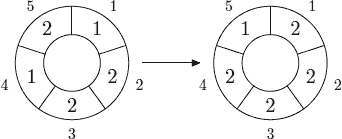POJ 3150/ UVA 1386 Cellular Automaton(矩阵乘法&循环矩阵)
来源:互联网 发布:如何删除部落冲突数据 编辑:程序博客网 时间:2024/06/02 07:53
Description
A cellular automaton is a collection of cells on a grid of specified shape that evolves through a number of discrete time steps according to a set of rules that describe the new state of a cell based on the states of neighboring cells. The order of the cellular automaton is the number of cells it contains. Cells of the automaton of order n are numbered from 1 to n.
The order of the cell is the number of different values it may contain. Usually, values of a cell of order m are considered to be integer numbers from 0 to m − 1.
One of the most fundamental properties of a cellular automaton is the type of grid on which it is computed. In this problem we examine the special kind of cellular automaton — circular cellular automaton of order n with cells of order m. We will denote such kind of cellular automaton as n,m-automaton.
A distance between cells i and j in n,m-automaton is defined as min(|i − j|, n − |i − j|). A d-environment of a cell is the set of cells at a distance not greater than d.
On each d-step values of all cells are simultaneously replaced by new values. The new value of cell i after d-step is computed as a sum of values of cells belonging to the d-enviroment of the cell i modulo m.
The following picture shows 1-step of the 5,3-automaton.

The problem is to calculate the state of the n,m-automaton after k d-steps.
Input
The first line of the input file contains four integer numbers n, m, d, and k (1 ≤ n ≤ 500, 1 ≤ m ≤ 1 000 000, 0 ≤ d < n⁄2 , 1 ≤ k ≤ 10 000 000). The second line contains n integer numbers from 0 to m − 1 — initial values of the automaton’s cells.
Output
Output the values of the n,m-automaton’s cells after k d-steps.
Sample Input
sample input #15 3 1 11 2 2 1 2sample input #25 3 1 101 2 2 1 2
Sample Output
sample output #12 2 2 2 1sample output #22 0 0 2 2
Source
题意:给你一个循环的数组,经过一次变换,每一个数变成原来数组里自己和距离自己不超过d的数字的和模m。
求k次变换后数组的值。
对于第一个样例,可以很轻松的构造出矩阵:
A:
1 2 2 1 2
B:
1 1 0 0 1
1 1 1 0 0
0 1 1 1 0
0 0 1 1 1
1 0 0 1 1
然后答案就是A*(B^k),然而,n有500那么大,复杂度就是O(n^3*log(k)),所以会超时。
但是我们观察发现B是一个循环矩阵,循环矩阵有一个性质 如果A是循环矩阵,那么A^2, A^3.....都是循环矩阵。
那么我们做矩阵乘法的时候就只用算出矩阵的第一行,下面每一行都可以由上一行推出,那么这样复杂度都变成了O(n^2*log(k)).
还有就是500*500在结构体里开不下,无奈只能用普通数组。
#include<cstdio>#include<cstring>#include<iostream>#include<algorithm>#define LL long longusing namespace std;int n,m,d,k;LL A[500][500],B[500][500],ans[500][500],t[500][500];void mul(LL a[500][500],LL b[500][500],LL ans[500][500]){ int i,j; memset(t,0,sizeof(t)); for(i=0;i<n;i++) for(j=0;j<n;j++) { t[0][i] += a[0][j]*b[j][i]; t[0][i] %= m; } for(i=1;i<n;i++) for(j=0;j<n;j++) t[i][j] = t[i-1][(j-1+n)%n]; for(i=0;i<n;i++) for(j=0;j<n;j++) ans[i][j] = t[i][j];}void pow(LL a[500][500],int k){ int i,j; for(i=0;i<n;i++) for(j=0;j<n;j++) ans[i][j] = (i==j); while(k) { if(k&1) mul(ans,B,ans); mul(B,B,B); k /= 2; } for(i=0;i<n;i++) for(j=0;j<n;j++) a[i][j] = ans[i][j];}int main(void){ int i,j; while(scanf("%d%d%d%d",&n,&m,&d,&k)==4) { memset(A,0,sizeof(A)); memset(B,0,sizeof(B)); for(i=0;i<n;i++) scanf("%lld",&A[0][i]); for(j=0;j<n;j++) { for(i=0;i<=d;i++) { B[(j+i)%n][j] = 1; B[(j-i+n)%n][j] = 1; } } pow(B,k); mul(A,B,ans); for(i=0;i<n-1;i++) printf("%d ",ans[0][i]); printf("%d\n",ans[0][i]); } return 0;}- POJ 3150/ UVA 1386 Cellular Automaton(矩阵乘法&循环矩阵)
- Poj 3150/UVA 1386/UVALive 3704 Cellular Automaton 循环矩阵
- UVA 1386 Cellular Automaton(循环矩阵)
- POJ 3150 / Uva 1386 Cellular Automaton 解题报告(循环矩阵)
- UVA 1386 - Cellular Automaton(循环矩阵)
- uva 1386 - Cellular Automaton(循环矩阵乘)
- poj_3150 Cellular Automaton(循环矩阵+矩阵乘法)
- uva 1386 - Cellular Automaton(循环矩阵+矩阵快速幂)
- UVA 1386 cellular automaton [循环矩阵+矩阵快速幂]【数学】
- 【poj 3150】Cellular Automaton 矩阵
- [POJ 3150] Cellular Automaton (矩阵快速幂 + 矩阵乘法优化)
- UVA Live 3704 Cellular Automaton (循环矩阵+快速幂)
- poj3150 && LA3704 Cellular Automaton 矩阵乘法 + 循环矩阵性质
- UVA1386-Cellular Automaton(循环矩阵)
- 【循环矩阵+矩阵快速幂】Cellular Automaton UVA
- POJ 3150 Cellular Automaton 矩阵dp
- POJ 3150 Cellular Automaton(矩阵快速幂)
- poj 3150Cellular Automaton(矩阵快速幂)
- 安装beautifuSoup
- 优达学城Numpy与Pandas笔记
- mac上解决java.rmi.server.ExportException- Port already in use- 1099; nested exception is- java.net.Bi
- JavaEE题
- I Love You Too
- POJ 3150/ UVA 1386 Cellular Automaton(矩阵乘法&循环矩阵)
- web性能优化之CSS篇
- ELK 5版本
- sklearn库实现SVM
- 第二弹——SSH远程连接和FTP文件传输
- 【C#】 泛型
- 前端JavaScript框架列表
- 最长递增子序列
- JavaScript Switch 语句


